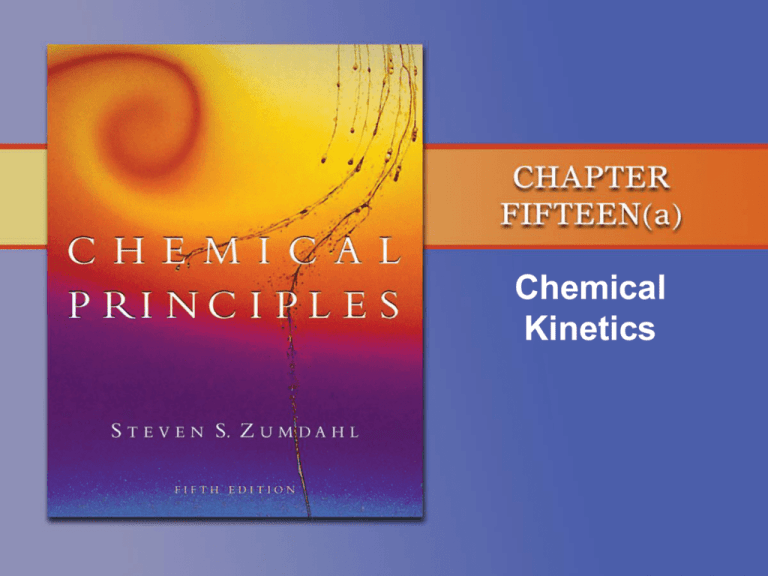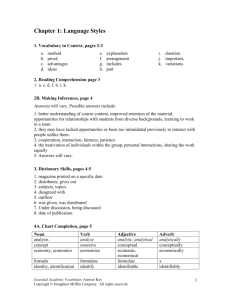
Chemical
Kinetics
Close-up of a crashing wave.
Source: Getty Images
Copyright © Houghton Mifflin Company. All rights reserved.
15a–2
Copyright © Houghton Mifflin Company. All rights reserved.
15a–3
Copyright © Houghton Mifflin Company. All rights reserved.
15a–4
Figure 15.1: Starting with pure nitrogen
dioxide at 300°C
Copyright © Houghton Mifflin Company. All rights reserved.
15a–5
Rate Law
instantaneous rate of reaction.
the concentration of
phenolphthalein in a solution
that was initially 0.005 M in
phenolphthalein and 0.61 M
in OH- ion.
Rate = k(phenolphthalein)
Copyright © Houghton Mifflin Company. All rights reserved.
15a–6
Examples of Rate Law
2 HI(g) H2(g) + I2(g)
CH3Br(aq) + OH-(aq)
CH3OH(aq) + Br-(aq)
Rate = k(CH3Br)(OH-)
(CH3)3CBr(aq) + OH-(aq)
But
(CH3)3COH(aq) + BrRate = k((CH3)3CBr)
Rate law is not related to stochiometry!
Copyright © Houghton Mifflin Company. All rights reserved.
15a–7
Decomposition of N2O5
Copyright © Houghton Mifflin Company. All rights reserved.
15a–8
Copyright © Houghton Mifflin Company. All rights reserved.
15a–9
Figure 15.2: Plot of the concentration of N2O5
Rate = k(N2O5)
Copyright © Houghton Mifflin Company. All rights reserved.
15a–10
Figure 15.3: A plot of In[N205] versus time.
Copyright © Houghton Mifflin Company. All rights reserved.
15a–11
Figure 15.4: Plot of [N2O5] versus time for the
decomposition reaction of N2O5.
Copyright © Houghton Mifflin Company. All rights reserved.
15a–12
Rate = k(X)
We then test this assumption by checking concentration versus time data
for the reaction to see whether they fit the first-order rate law.
ln (X) - ln (X)0 = - kt y = mx + b
ln (X) = -kt + ln (X)0
Copyright © Houghton Mifflin Company. All rights reserved.
15a–13
2nd Order Reaction
Rate = k(X)2
Copyright © Houghton Mifflin Company. All rights reserved.
15a–14
Copyright © Houghton Mifflin Company. All rights reserved.
15a–15
Copyright © Houghton Mifflin Company. All rights reserved.
15a–16
Solution containing BrO3-
Copyright © Houghton Mifflin Company. All rights reserved.
15a–17
Butadiene and its dimer
Copyright © Houghton Mifflin Company. All rights reserved.
15a–18
Figure 15.5: (a) A plot of ln[C4H6] versus t.
(b) A plot of 1/[C4H6] versus t.
Copyright © Houghton Mifflin Company. All rights reserved.
15a–19
Figure 15.6: Plot of [A] versus t for a
zero-order reaction
Copyright © Houghton Mifflin Company. All rights reserved.
15a–20
Figure 15.7: Decomposition reaction takes
place on a platinum surface
Copyright © Houghton Mifflin Company. All rights reserved.
15a–21
Copyright © Houghton Mifflin Company. All rights reserved.
15a–22
Figure 15.8: Molecular representation of the
elementary steps in the reaction of NO2 and CO.
Copyright © Houghton Mifflin Company. All rights reserved.
15a–23
Copyright © Houghton Mifflin Company. All rights reserved.
15a–24
Single Step Reaction
CH3Br(aq) + OH-(aq)
CH3OH(aq) + Br-(aq)
Rate = k(CH3Br)(OH-)
Copyright © Houghton Mifflin Company. All rights reserved.
15a–25
Multiple Step Reaction
(CH3)3CBr(aq) + OH-(aq)
(CH3)3COH(aq) + Br-(aq)
(CH3)3CBr (CH3)3C+ + Br- Slow step
(CH3)3C+ + H2O (CH3)3COH2+ Fast step
(CH3)3COH2+ + OH- (CH3)3COH + H2O Fast step
Copyright © Houghton Mifflin Company. All rights reserved.
15a–26
General Rules for Rate Law
•The rate of any step in a reaction is directly
proportional to the concentrations of the
reagents consumed in that step.
•The overall rate law for a reaction is
determined by the sequence of steps, or the
mechanism, by which the reactants are
converted into the products of the reaction.
•The overall rate law for a reaction is dominated
by the rate law for the slowest step in the
reaction.
Copyright © Houghton Mifflin Company. All rights reserved.
15a–27
The rate a
which this
colored
solution enters
the flask is
determined by
the size of the
funnel stem,
not how fast the
solution is
poured.
Source: American Color
Copyright © Houghton Mifflin Company. All rights reserved.
15a–28
Slow and Fast reactions shown
as molecular models
Copyright © Houghton Mifflin Company. All rights reserved.
15a–29
Figure 15.10:
A plot
showing the
exponential
dependence
of the rate
constant on
the
absolute
temperature
Copyright © Houghton Mifflin Company. All rights reserved.
15a–30
Figure 15.11: The change in potential energy as a
function of reaction progress for the reaction
Copyright © Houghton Mifflin Company. All rights reserved.
15a–31
Figure 15.12: Plot showing the number of
collisions with a particular energy
Copyright © Houghton Mifflin Company. All rights reserved.
15a–32
Figure 15.13: Several possible orientations
for a collision between two BrNO molecules.
Copyright © Houghton Mifflin Company. All rights reserved.
15a–33
Figure 15.14:
Plot of In(k)
versus 1/T
for the
reaction
Copyright © Houghton Mifflin Company. All rights reserved.
15a–34
Figure 15.15: Energy plots for catalyzed and
uncatalyzed pathways for a given reaction
Copyright © Houghton Mifflin Company. All rights reserved.
15a–35
Homogeneous Catalysis
H2O2(aq) + I-(aq)
H2O(aq) + OI-(aq)
In the second step, the OI- ion is reduced to I- by
H2O2.
OI-(aq) + H2O2(aq)
H2O(aq) + O2(g) + I-(aq
)
the first step in this reaction is the rate-limiting step,
Copyright © Houghton Mifflin Company. All rights reserved.
15a–36
Figure 15.16: Effect of a catalyst on the
number of reaction-producing collisions.
Copyright © Houghton Mifflin Company. All rights reserved.
15a–37
Figure 15.17: Heterogeneous catalysis
of the hydrogenation of ethylene.
Copyright © Houghton Mifflin Company. All rights reserved.
15a–38
Figure 15.18: The exhaust gases from an automobile
engine are passed through a catalytic converter to
minimize environmental damage.
Copyright © Houghton Mifflin Company. All rights reserved.
15a–39
General structure of protein
Copyright © Houghton Mifflin Company. All rights reserved.
15a–40
Figure 15.19: Removal of the end amino acid
from a protein by reaction with a molecule of water.
Copyright © Houghton Mifflin Company. All rights reserved.
15a–41
Figure 15.20: Structure of the enzyme
carboxypeptidase-A, which contains 307 amino acids.
Copyright © Houghton Mifflin Company. All rights reserved.
15a–42
Figure 15.21: Protein-substrate interaction
Copyright © Houghton Mifflin Company. All rights reserved.
15a–43
Cutaway model of a catalytic converter
used in automotive exhaust systems.
Source: Delphi Automotive Systems
Copyright © Houghton Mifflin Company. All rights reserved.
15a–44
Collect
samples of
extremophiles
from
Copyright © Houghton Mifflin Company. All rights reserved.
15a–45
A micrograph of the extremophile Archaeoglobus
fulgidis, and organis that lives in the hot sediments near
submarine hydrothermal vents.
Source: Photo Researchers, Inc.
Copyright © Houghton Mifflin Company. All rights reserved.
15a–46
Reaction coordinate
Copyright © Houghton Mifflin Company. All rights reserved.
15a–47
Reaction coordinate
Copyright © Houghton Mifflin Company. All rights reserved.
15a–48
Rate
Copyright © Houghton Mifflin Company. All rights reserved.
15a–49
Concentration of reactant
Copyright © Houghton Mifflin Company. All rights reserved.
15a–50
Time (s); Time (s); Time (s)
Copyright © Houghton Mifflin Company. All rights reserved.
15a–51
Laser spectroscopy
Source: California Institute of Technology
Copyright © Houghton Mifflin Company. All rights reserved.
15a–52
Figure 15.9: The STM images of the
reaction of CO and O2
Source: University of California, Irvine
Copyright © Houghton Mifflin Company. All rights reserved.
15a–53

